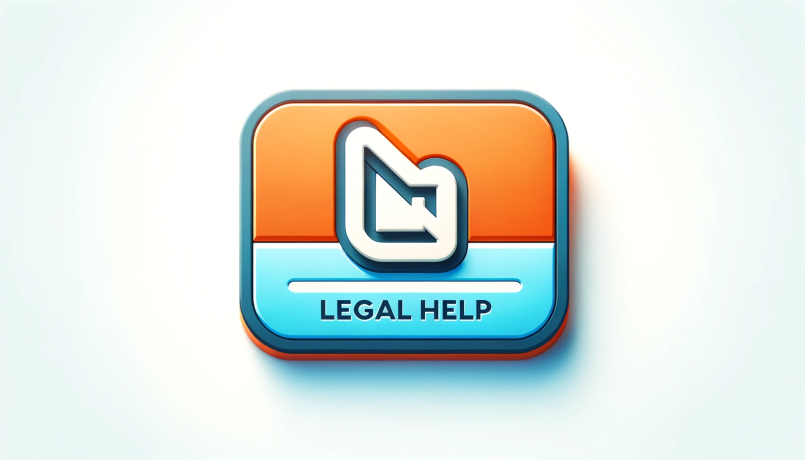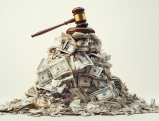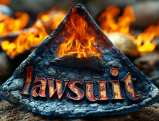
In California, victims of natural disasters like floods and fires can seek compensation for their losses through personal injury claims. This guide offers vital information on legal strategies and expert advice for successfully navigating these complex claims.
by LawInc Staff
May 4, 2024
Natural disasters like floods, wildfires, earthquakes and mudslides inflict devastating losses across California each year. When preventable factors like inadequate infrastructure maintenance, subpar construction practices or insufficient emergency response protocols exacerbate harm, injury victims may hold responsible parties liable through personal injury litigation.
This guide explores core legal considerations shaping valid claims and key factors distinguishing top attorneys best equipped to secure maximum recovery. We detail essential case merits, evidence gathering priorities, liability attribution nuances and more so disaster victims understand available recourse options.
1. Determining Claim Validity and Scope
-
- Proving Negligence Worsened Impacts: Valid claims must establish preventable factors unnecessarily magnified harm.
- Documenting Proximate Cause: Clear links between unreasonable conduct and specific injuries are essential.
- Quantifying Compensatory Damages: Medical bills, property losses, lost wages and other economic harm.
- Insufficient Government Aid: Public recovery funds often prove inadequate, necessitating private legal action.
- Identifying Proper Defendants: Parties like utilities, builders, public agencies may share liability.
Examples:
-
- Faulty power line maintenance sparked Thomas’ home burning down in Kincade Fire.
- Structural foundation issues directly worsened liquefaction damage in Ridgecrest quake for Angela.
- Samuel’s $120,000 property losses, $55,000 medical costs after Montecito mudslides.
- FEMA aid covered under 20% of Laura’s Oroville Dam crisis destruction.
- Lydia named county, contractors, and permit agencies after code violation injuries in flood.
How to Proceed:
-
- Extensively document all physical, financial and emotional injuries to fully assess case value.
- Retain experts to prove how reasonable protections would have prevented harm.
- Compare losses to aid limits to demonstrate necessity of legal recovery.
- Name public and private defendants sharing responsibility for enabling preventable destruction.
- Consult qualified counsel to analyze facts and determine worthiness of pursuing claims.
FAQs:
-
- What’s the statute of limitations on disaster claims? Usually 2 years but may vary by specific case details.
- Are class actions better than individual suits? Depends on shared vs distinct issues – consult attorney for personal analysis.
- Can I claim against government entities? Yes but stricter rules and deadlines apply so seek guidance quickly.
- Will my homeowners/renters insurance cover losses? Policies vary – have counsel review for exclusions and limits.
- Do I need professional damage valuations? Expert assessments prove repair scope and expense for maximum recovery.
2. Rigorous Evidence and Record Gathering
-
- Preserving Physical Evidence: Damaged property, injury photos, defective products before spoliation.
- Medical Documentation: Diagnosis and prognosis records, treatment plans, anticipated care needs.
- Expert Witness Reports: Engineers, meteorologists, public safety officials on preventative failures.
- Historical Data: Similar prior incidents, unheeded warnings, personnel training gaps.
- Witness Accounts: Observers documenting defendant actions/inactions worsening harm.
Examples:
-
- Todd preserved his cracked home foundation and ruptured gas line materials after San Andreas jolts.
- Records projected Stephanie’s lifelong asthma and COPD costs after Woolsey Fire smoke exposure.
- Seismic experts verified how Daniel’s apartment met only 10% of recommended retrofitting codes pre-collapse.
- Discovery revealed 3 prior identical failures at Victor’s housing complex during heavy rains.
- Neighbors testified detailing road crew actions that diverted floodwaters into Paula’s home.
How to Proceed:
-
- Secure and organize all evidence of insufficient precautions and resulting harms.
- Obtain FOIA reports on utility/transit/infrastructure breakdowns and emergency response gaps.
- Consult subject matter experts to assess if proper protocols would have lessened toll.
- Interview neighbors and first responders on potential defendant missteps.
- Select attorneys experienced in evidence rules, chain of custody, and admissibility standards.
FAQs:
-
- What if I discarded damaged items? Photographs, repair records or insurance docs help but save evidence if possible.
- How detailed must medical records be? More specifics on diagnoses, limitations, and future needs maximize recovery.
- Can expert testimony be challenged? Yes, so vet credentials, experience, and past consistency carefully.
- Will witnesses stay cooperative long-term? Get statements early while memories fresh and willingness high.
- What if officials block inquiries? Skilled counsel compels disclosure so contact attorney for issuing subpoenas.
3. Adapting to Disaster-Specific Complexities
-
- Flood and Mudslide Cases: Evaluating levee integrity, zoning/grading missteps, water diversion failures.
- Wildfire Matters: Examining utility equipment maintenance, brush clearance, firefighter resource allocation.
- Earthquake Litigation: Investigating construction reinforcement standards, foundation stability, retrofit histories.
- Public Defendant Nuances: Following distinct claim notification procedures and timelines.
- Large-Scale Impact Scope: Analyzing broader regional patterns to establish unreasonable conduct norms.
Examples:
-
- Frank’s neighborhood flooded after county failed to repair breeched levee walls for months pre-storm.
- Nina’s home burned in a wildfire when utility didn’t trim back dead trees encroaching on power lines.
- Hector suffered injuries when his office tower pancaked due to substandard seismic construction safeguards.
- Tina filed an administrative claim with the city after its broken water main triggered a destructive mudslide.
- Widespread transformer explosions during high winds revealed systemic inspection lapses across Jill’s region.
How to Proceed:
-
- Research specific codes, regulations and best practices applying to the particular disaster scenario.
- Investigate broader history of substandard safety practices by defendants across wider geographic areas.
- Comply with all distinct prerequisites and deadlines for claims against government entities.
- Participate in class actions if available and advisable for consistent issue efficient resolution.
- Partner with law firms that have successful track records with the specific variety of natural disaster cases at hand.
FAQs:
-
- What building codes apply in earthquake cases? Seismic standards vary by structure type, height, occupancy and construction date.
- Do powerline regulations differ across regions? While baseline state rules exist, some local governments have stricter ordinances.
- How do I know if a class action is right for me? Consult counsel for an individualized assessment based on your case specifics.
- What if I miss a government claim deadline? Some limited exceptions may apply but generally this bars suing, so pay close attention.
- How can an attorney help determine case type? Evaluating facts, interviewing experts and researching precedent reveals strongest approach.
4. Strategic Case Valuation and Resolution Approach
-
- Accounting for Future Impacts: Projecting long-term medical needs, earnings losses, property re-repair, trauma.
- Leveraging Punitive Damages: Egregious wrongdoing opens door to punishment beyond compensation.
- Proving Public Impact: Magnified community harms increase verdict and settlement value.
- Venue and Timing Priorities: Friendly jurisdictions and fresh indignation boost outcomes.
- Negotiation vs Litigation: Weigh defendant risk tolerance and precedent value of trial.
Examples:
-
- Natalie’s spinal cord injury will require millions in adaptive housing and transportation modifications for decades.
- Punitive damages multiplied awards tenfold after Mitch’s apartment owner was cited for illegal construction five times before its collapse.
- Evidence that 3000+ residents were harmed by the flood elevated Javier’s compensation even absent major personal injuries.
- With public outrage at its peak, Bonnie’s attorney expedited filing in preferred county to maximize settlement.
- Greg’s lawyer balanced certain compensation now with the power of creating appellate precedent benefiting future plaintiffs.
How to Proceed:
-
- Retain life care planners and forensic economists for detailed damage projections to warrant maximum awards.
- Research and argue similar cases where courts permitted punitive multipliers for comparable misconduct.
- Gather data quantifying communal impacts that magnify case value beyond individual harms.
- File quickly in ideal venues leveraging public sentiment before it fades and while evidence remains fresh.
- Assess defendant financial status, risk aversion, and case strength and novelty in deciding resolution path.
FAQs:
-
- How do I find a life care planner? Ask your attorney – established firms have networks of trusted experts in this field.
- What factors influence punitive damage availability? Degree of defendant wrongdoing, prior history, ability to pay.
- Does community impact always increase case value? Not always but often – especially with evidence many suffered similar preventable harm.
- What’s the most plaintiff-friendly venue? Depends on case type but LA, Alameda, and San Francisco counties tend to be popular.
- Should I always sue or settle? Case-specific calculus on speed, certainty, and precedent value – consult your attorney.
Summary

Did You Know? Recent studies show California experiences an average of $4.7 billion in natural disaster destruction annually with less than 10% covered by insurance, necessitating legal action for many victims to recover.
When nature’s wrath strikes the Golden State, victims face arduous paths to restoring normalcy. Strategic legal advocacy proves essential for achieving accountability against parties who failed to take reasonable precautions to prevent cataclysmic losses.
Top California disaster attorneys bring specialized knowledge of relevant case law, investigate with tenacity to surface culpability, and position deserved compensation persuasively. With their dedicated guidance, plaintiffs can navigate complex litigation to secure funds rebuilding shattered lives and infrastructure.
Considering a Disaster Claim? Learn Your Options
If you or a loved one suffered harm in a California natural disaster due to potential negligence, don’t face the aftermath alone. Contact us to be connected with an experienced attorney who can advise on the best path forward protecting your health, property, and financial wellbeing.
Assess Your Disaster Damage Claim Awareness
Questions: Determining Claim Validity and Scope
-
- 1. What’s required to prove a valid disaster injury claim?
- A) Verifying disaster occurred
- B) Quantifying all losses
- C) Showing negligence
- D) Naming any defendant
- 2. Why might liability be shared across defendants?
- A) Multiple parties made errors
- B) Made suing easier
- C) Created redundant payers
- D) No particular reason
- 3. When can government agencies be sued for disaster losses?
- A) Never
- B) Only if no budget
- C) If enable preventable harms
- D) Always
- 4. What if I received FEMA or state aid – can I still sue?
- A) No, aid waives rights
- B) Yes, if aid insufficient
- C) Yes, but aid reduces recovery
- D) Depends on aid type
- 5. How much do I need to be harmed to warrant a claim?
- A) No minimum if negligent
- B) At least $10,000
- C) Over $100,000
- D) $1 million plus
- 1. What’s required to prove a valid disaster injury claim?
Answers: Determining Claim Validity and Scope
-
- 1. C) Proving a defendant’s negligence directly enabled preventable harm forms the core of a valid disaster injury claim.
- 2. A) Liability may be shared when multiple parties – government agencies, utilities, builders, etc. – fell short of their duties.
- 3. C) Government entities can be sued if their unreasonable conduct created danger, but special claim rules apply.
- 4. B) Receiving aid alone doesn’t preclude lawsuits, especially when losses far exceed assistance, but awards may offset aid.
- 5. A) If a defendant’s negligence caused losses, a victim can pursue a claim even for lower-value cases.
Questions: Evidence and Record Gathering
-
- 1. What’s the most critical evidence in disaster cases?
- A) Photos of damage
- B) Receipts of expenses
- C) Proof of negligence
- D) Witness statements
- 2. How can I compel a defendant to release key records?
- A) Impossible without a suit
- B) File FOIA requests
- C) Lawyer subpoenas
- D) Both B and C
- 3. What’s most important for medical record details?
- A) Doctor’s credentials
- B) Full treatment history
- C) Insurer information
- D) Hospital rankings
- 4. Why get expert witness guidance quickly?
- A) Lock in testimony
- B) Preserve evidence
- C) Understand issues
- D) All of the above
- 5. Should I rely on officials to provide evidence voluntarily?
- A) Yes, they have to by law
- B) No, may resist disclosure
- C) Depends on the agency
- D) Depends on the records
- 1. What’s the most critical evidence in disaster cases?
Answers: Evidence and Record Gathering
-
- 1. C) While documenting damages is crucial, evidence proving a defendant’s negligence is most critical.
- 2. D) Both FOIA requests to government agencies and subpoenas from attorneys can compel key evidence disclosure.
- 3. B) Detailed medical histories matter most, linking the incident to specific diagnoses and care needs.
- 4. D) Early expert input identifies issues, guides evidence preservation, and locks in testimony.
- 5. B) Don’t count on voluntary disclosure – agencies may resist, so partner with lawyers to pursue evidence.
Questions: Disaster-Specific Complexities
-
- 1. What’s a common issue in California wildfire cases?
- A) Power line maintenance
- B) Helicopter water drops
- C) Firefighter staffing
- D) Citizen evacuations
- 2. In flood cases, who may face liability besides government?
- A) Architects and engineers
- B) Hydrologists and geologists
- C) Construction firms
- D) All of the above
- 3. What building collapse cases often hinge on in quakes?
- A) Seismic code updates
- B) Contractor licensing
- C) Owner occupancy rates
- D) Tenant demographics
- 4. What helps prove systematic issues in large regions?
- A) Similar damages
- B) Cluster timing
- C) Common defendants
- D) All of the above
- 5. Who determines if government claims meet deadlines?
- A) Legislators
- B) Agencies themselves
- C) Judges
- D) Third-party auditors
- 1. What’s a common issue in California wildfire cases?
Answers: Disaster-Specific Complexities
-
- 1. A) Poor utility line maintenance causing sparks is a common trigger in major California wildfire cases.
- 2. D) Architects, engineers, builders and more may be liable beyond governments for enabling flood losses.
- 3. A) Earthquake cases often turn on if structures met changing seismic resistance codes over time.
- 4. D) Similar cluster damages from common defendants in compressed periods help prove systematic faults.
- 5. B) Agencies themselves usually determine timeliness, though courts may overrule in lawsuits.
Questions: Case Valuation and Resolution Approach
-
- 1. What most impacts long-term medical damages?
- A) Diagnosis
- B) Prognosis
- C) Treatment
- D) All of the above
- 2. What justifies punitive damage multipliers?
- A) Extreme negligence
- B) Intentional choices
- C) Repeat violations
- D) Any of the above
- 3. Why consider filing cases quickly after disasters?
- A) Meet statute of limitations
- B) Preserve fresh evidence
- C) Leverage public sympathy
- D) All of the above
- 4. What helps decide between settling and suing?
- A) Defendant solvency
- B) Precedent value
- C) Liability strength
- D) All of the above
- 5. Who provides key input on lifetime care costs?
- A) Doctors
- B) Life care planners
- C) Forensic economists
- D) All of the above
- 1. What most impacts long-term medical damages?
Answers: Case Valuation and Resolution Approach
-
- 1. D) The combination of diagnoses, prognoses and treatment plans together determine long-term medical damages.
- 2. D) Extreme negligence, intentional acts and repeat offenses can all warrant punitive damage multipliers.
- 3. D) Filing quickly protects rights, evidence and momentum for maximum negotiating leverage.
- 4. D) Case strength, defendant means, and creating helpful precedent all factor into settlement vs trial decisions.
- 5. D) Medical, planning and economic experts together project lifetime injury treatment and adaptation needs.
Disclaimer
The information in this article on California natural disaster injury claims is provided for general education and guidance only. The content does not constitute specific legal advice and does not create an attorney-client relationship. While we strive to present accurate and current information, we make no representations regarding the certainty of outcomes from the use of this information. Details of individual situations can affect the applicability of the concepts discussed. For legal advice tailored to your unique circumstances, please consult a licensed California personal injury attorney. The State Bar of California and local bar associations maintain directories of attorneys in good standing and offer referral services to aid the public in obtaining appropriate legal counsel.
Read More
Best Injury Lawyers in California | What They All Have in Common











